Vue3 尝鲜
Posted Vue社区
tags:
篇首语:本文由小常识网(cha138.com)小编为大家整理,主要介绍了Vue3 尝鲜相关的知识,希望对你有一定的参考价值。
关注 Vue社区,回复“加群”
BeStill
juejin.im/post/5e13ecbe6fb9a04846508ab2
Github源码: https://github.com/vuejs/vue-next
前言
也没啥好说的,直奔主题

Vue3 相对于 Vue2 有那些更改?
Object.defineProperty => Proxy
重构了虚拟DOM
OptionApi => Composition API
如何调试
首先,在GitHub上拉取最新代码
git pull https://github.com/vuejs/vue-next.gitcd vue-next && yarn
下载完成之后打开代码, 开启sourceMap 1、tsconfig.json 把sourceMap字段修改为true
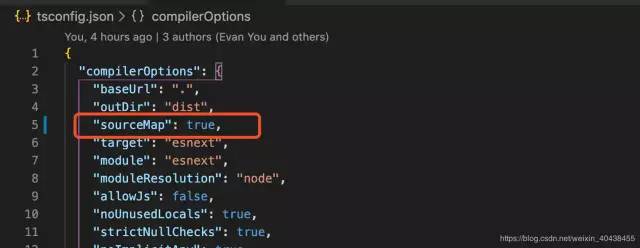
2、rollup.config.js 在rollup.config.js中,手动键入output.sourcemap = true
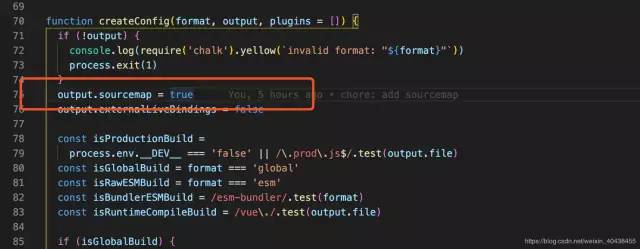
3、yarn dev

4、在根目录创建一个demo目录用于存放示例代码 并在demo目录下创建html、js文件,引入构建后的vue文件
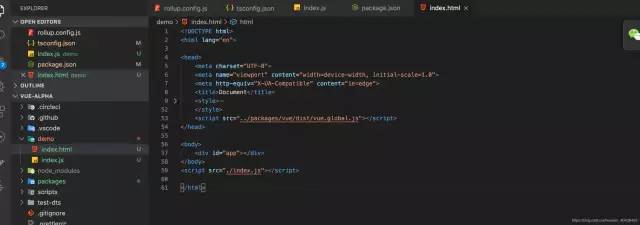
第一个Hello World!!!
/demo/index.html
<html lang="en"><head><meta charset="UTF-8"><meta name="viewport" content="width=device-width, initial-scale=1.0"><meta http-equiv="X-UA-Compatible" content="ie=edge"><title>Document</title><style>.container {text-align: center;font-size: 24px;padding: 32px;}</style><script src="../packages/vue/dist/vue.global.js"></script></head><body><div id="app"></div></body><script src="./index.js"></script></html>
/demo/index.js
const { reactive } = Vuevar App = {template: `<div class="container">{{message}}</div>`,setup() {const state = reactive({message: "Hello World!!!"})return {...state}}}Vue.createApp().mount(App, '#app')
在浏览器打开咱们编写的html文件,

这里的服务器环境使用serve库来创建的,有兴趣的话可以看下serve
(https://www.npmjs.com/package/serve)
anyway,咱们接着看咱们的/demo/index.js文件,可以看到,咱们用了setup, reactive等函数,这就是Vue3的Composition API,相对于Vue2的组件来说 3 可以让我们很简单的通过组合API的方式创建一个 基于Vue3 响应式 Web 应用。 下边我会通过一个个的demo为大家详细解释这些API。
接下来咱们实现一个双向绑定的demo!!!
双向绑定的demo
const { reactive } = Vuevar App = {template: `<div class="container"><input v-model="value"/>{{value}}</div>`,setup() {const state = reactive({ value: '' })return {...state}}}Vue.createApp().mount(App, '#app')

setup是干啥的?? setup实际上是一个组件的入口,它运行在组件被实例化时候,props 属性被定义之后,实际上等价于 2 版本的beforeCreate 和 Created 这两个生命周期。
setup接受两个参数,第一个参数是props, 另一个参数是context,所以大家在使用2.0时习惯的在this下获取属性的方式 ,在 vue3.0 中,变成了:
setup(props, ctx) {console.log(props, ctx)}
不过在模板中仍然可以直接使用props的属性值,例如:
let Child = {template: `<div>{{title}}</div>`,setup(props, context) {console.log(props)}}var App = {template: `<div class="container"><Child title="test props"/></div>`,components: { Child }}Vue.createApp().mount(App, '#app')

那reactive???之前用的 data呢??? 在Vue3中,我们可以把数据经过 reactive 加工变成响应式的对象,用于模版的渲染数据, 当然Vue的向下兼容 还是允许我们使用data的方式实现,但既然Vue3出新的写法了,何不尝试一波呢
计数器 demo
const { reactive, toRefs } = Vuevar App = {template: `<div class="container">count: {{count}}<button ="handlerCountAdd"> Click ++ </button></div>`,setup() {const state = reactive({ count: 0 })const handlerCountAdd = () => {state.count++}return { ...toRefs(state), handlerCountAdd }}}Vue.createApp().mount(App, '#app')

这个toRefs是??????????? 在说这个之前 我想先说下 ref ,vue3提供的ref让我们有机会创建单个的响应式的对象,在setup函数中return出去之后,在模板中可直接访问,例:
const App = {template: `<div class="container">{{value}}</div>`,setup() {const value = ref(1)return value}}Vue.createApp().mount(App, '#app')

可以看到 value已经被渲染到页面上。 那上文提到的 reactive创建的响应式对象 在模板中访问的话,则需要state.xxx, 例:
const App = {template: `<div class="container">{{state.value}}</div>`,setup() {const state = reactive({ value: 'reactive' })return { state }}}Vue.createApp().mount(App, '#app')
这样访问属性确实有点麻烦,vue3提供的toRefs正是为我们解决这个问题的,toRefs把一组的响应式对象拆成单个的响应式对象,就能够在模板中直接访问了,及:
const App = {template: `<div class="container">{{value}}</div>`,setup() {const state = reactive({ value: 'reactive' })return toRefs(state)}}Vue.createApp().mount(App, '#app')
反转字符串 demo
var App = {template: `<div class="container">value: <input v-model="value"/><br/>rvalue: {{rvalue}}</div>`,setup() {const state = reactive({value: '',rvalue: computed(() =>state.value.split('').reverse().join(''))})return toRefs(state)}}Vue.createApp().mount(App, '#app')

这个demo中 我们用到了computed计算属性实现了反转字符串的功能,这个函数虽然简单,但是功能很强大,正如vue官网所说:对于任何复杂逻辑,你都应当使用计算属性。
数据响应式
大家都知道, 在Vue3中实现数据响应式的方案由Vue2中的Object.defineProperty 换成了 Proxy,关于数据响应式的Api上边说到了一些,还剩下effect和watch没有提及到,effect是数据响应式中重要的一部分,watch和computed都是基于 effect 的,下边来看下代码
var App = {template: `<div class="container">count: {{count}}<button @click="handlerCountAdd"> Click ++ </button></div>`,setup() {const state = reactive({ count: 0, value: 1 })const handlerCountAdd = () => {state.count++}watch(() => state.count,val => {console.log('watch', state.count)console.log('watch', state.value)})effect(() => {console.log('effect', state.count)console.log('effect', state.value)})return { ...toRefs(state), handlerCountAdd }}}Vue.createApp().mount(App, '#app')
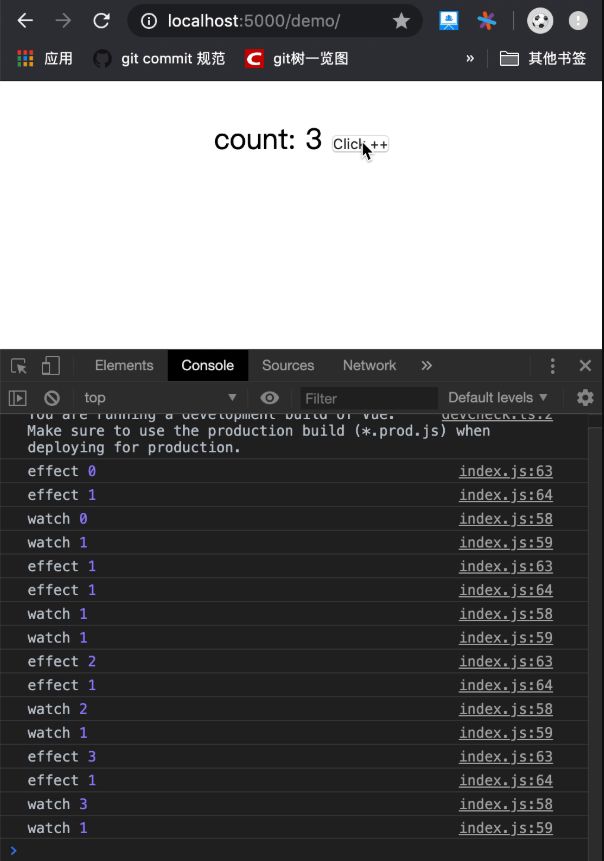
代码是基于上边计数器的demo来实现的,可以看到咱们点击click++的时候,effect和watch都可以监听到咱们数据的变化,从而根据业务作出相应的操作, 看到这里,大家可能会有一个疑问,那就是,既然effect和watch都能监听到数据的变化,那两者有什么区别呢?
首先,effect 在响应式数据变化的时候就会执行,执行次数根据响应式数据的个数来决定,例如
var App = {template: `<div class="container"><button @click="handlerCountAdd"> Click ++ </button></div>`,setup() {const r = ref(1)const s = ref(1)const t = ref(1)const handlerCountAdd = () => {r.value *= 1s.value *= 2t.value *= 3}effect(() => {console.log('effect', [r.value, s.value, t.value])})return { handlerCountAdd }}}Vue.createApp().mount(App, '#app')
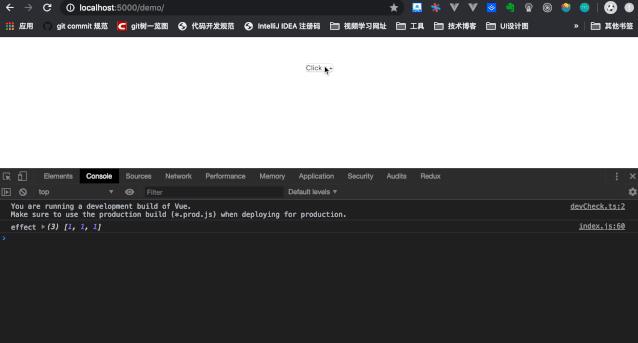
如上图所示: 我们点击一次同时更新三个ref,effect就会被执行三次。
而watch则点击一次 ,只会触发执行一次
var App = {template: `<div class="container"><button @click="handlerCountAdd"> Click ++ </button></div>`,setup() {const state = reactive({ count: 0, value: 1 })const r = ref(1)const s = ref(1)const t = ref(1)const handlerCountAdd = () => {r.value *= 1s.value *= 2t.value *= 3}watch([r, s, t], val => {console.log('watch', val)})return { handlerCountAdd }}}Vue.createApp().mount(App, '#app')
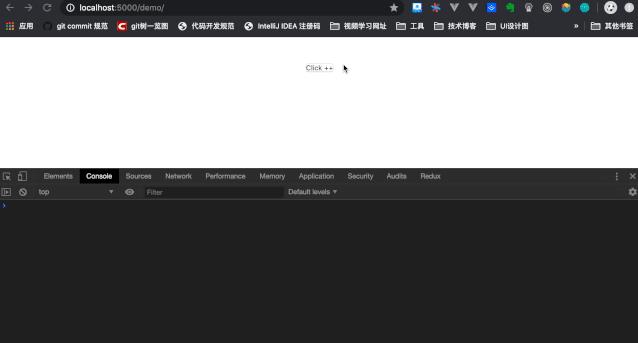
vue3 Watch的源码在这里有兴趣的小伙伴可以研究研究
(https://github.com/vuejs/vue-next/blob/master/packages/runtime-core/src/apiWatch.ts)
好了,vue3Composition Api中常用的一些函数在咱上边的demo中使用了,接下来咱们对比一下2和3的生命周期函数有什么改变
| Vue2 | Vue3 |
|---|---|
| beforeCreate | setup(替代) |
| created | setup(替代) |
| beforeMount | onBeforeMount |
| mounted | onMounted |
| beforeUpdate | onBeforeUpdate |
| updated | onUpdated |
| beforeDestroy | onBeforeUnmount |
| destroyed | onUnmounted |
| errorCaptured | onErrorCaptured |
Tips: 为什么不直接运行 yarn dev,而要先开启sourceMap?
虽然Vue官方说可以直接运行run dev 就可以对其进行调试,可是运行该命令后,是生成过后的代码,不能对其编写的ts源码进行调试。
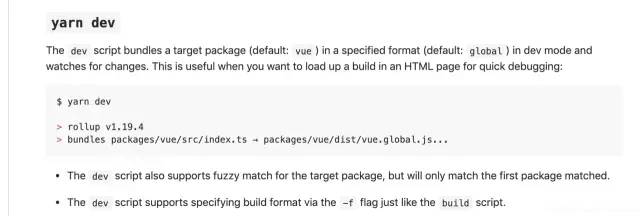
开启了sourcemap之后,在编译时会生成对应的sourcemap文件,然后赞么就可以在浏览器愉快的使用断点调试Vue的源代码了
Thank You
篇幅很大,感谢大家耐心观看,文中如有错误欢迎指正。
❤️ 看完两件事
如果你觉得这篇内容对你挺有启发,我想邀请你帮我两个小忙:
点个「在看」,让更多的人也能看到这篇内容(喜欢不点在看,都是耍流氓 -_-)
回复「100」免费获取 100本 最棒的前端电子书!
以上是关于Vue3 尝鲜的主要内容,如果未能解决你的问题,请参考以下文章